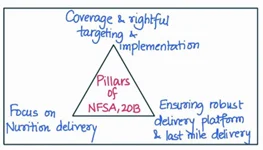Ans:
| Approach:
Introduction
- Give a brief on National Food Security Act (NFSA)
Body
- Enlist the features of NFSA
- Elaborate on the role of NFSA in eliminating hunger and malnutrition.
Conclusion
- Conclude stating that NFSA has been a game changer but it has to evolve a lot in order to achieve all of its objectives and also SDGs.
|
Introduction:
The National Food Security Act, 2013 aims to provide subsidized food grains to approximately two-third of the country’s population. The enactment of this landmark legislation, brought a paradigm shift in India’s approach to food security i.e., from welfare to rights-based approach.

Body:
The salient features of the act are as:
- Coverage and entitlement: Up to 75% of rural and 50% of the urban population will be covered under TPDS, with uniform entitlement of 5kg/person/month ration. Antyodaya households have a greater entitlement at 35kg/household.
- Identification of households: The work of identification of eligible households is to be done by States/UTS.
- Women empowerment: Eldest women of the household of age 18 years or above to be deemed as head of the household for the purpose of issuing ration cards.
- Maternity benefit: Pregnant Women and Lactating Mothers (PWLM) are entitled to receive maternity benefits of not less than 6000 rupees.
- Nutritional support: PWLM and children in the age group of 6 months to 14 years will be entitled to meals as per prescribed nutritional norms under ICDS, MDM (PM-Poshan).
- Grievance Redressal: A dedicated mechanism for grievance redressal at district and state level.
- Transparency/Accountability: Provisions regarding social audits, setting up of vigilance committees, disclosure of PDS records etc.
- Food security allowance: The beneficiaries are entitled to this allowance in case of non-supply of entitled food grains or meals.
Role of NFSA in eliminating hunger and malnutrition:
- According to a UN report, the number of undernourished people in India has declined by 60 million between 2006 to 2019. As per FAO report 2021, undernourishment reduced from 22 to 15%.
- Improved access to food grains have improved the hunger outcomes amongst the poor and underprivileged.
- Wide coverage of the 2/3rd population has increased resilience in the poor against income shocks. They are more secure in terms of surety in access to food grains.
- Stunting in children under 5 years of age has decreased from 38% in NFHS-4 to 35% in NFHS-5.
- Monetary compensation has compensated against wage loss during pregnancy. PWLM can now access healthier food options like fruits, vegetables etc.
- The awareness generated by the Asha workers has increased the number of infants who were exclusively breastfed from 11.2 million in 2012 to 13.9 million in 2019.
Conclusion:
NFSA has been a game changer but there is still a long way to go for India as India still has one of the highest number of people facing hunger, a highly anemic women population, etc. NFSA has ensured access to food grains; however, the need is to move towards nutritional security and not just food security. Recommendations of Shanta Kumar committee, Nandan Nilekani committee, etc. must be taken into consideration for effective implementation of NFSA, 2013.
